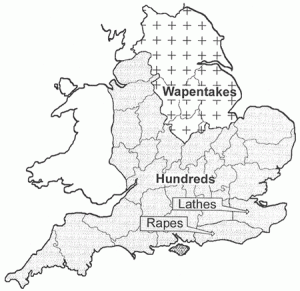
Sac and Soke and their derivitives (socage, sokeman, sake, soc) are found so frequently in so many different contexts, I finally started to question whether I understood them at all. It appears that these terms are more complicated than I first thought.
The basic definition implies a feudal-like tenancy, where the sokeman rendered non-military services to his lord (using soke as related to ploughshare). The sokeman apparently ranked between the free tenant and the bond tenant (or villein). He was a free man within the lord’s soke, or jurisdiction. But it does not stop there. According to Peter Rex in his “HAROLD II” book (p.276), “Then there is the Anglo-Scandinavian institution called a ‘soke‘. This was an estate made up of a main or central village and dependent pieces of property called variously berewicks or sokelands. The tenant of a soke, called a sokeman, held his land by attending the court of his lord, the holder of the soke, and by paying him a money rent and rendering various services of a non-military kind. The sokes were governed by a great body of custom requiring the sokemen to seek the lord’s court, his mill, his sheepfold, his church and so on, to the exclusion of other competing institutions.” Reminds me a lot of the later manorial system.
So apparently, sake and soke had more to do with judgments and fines than mere service owed as a tenant, although service was certainly an integral part of it. A man could possess sac and soke over others of lower rank (but not over himself), and a sokeman was the one who did the owing. Apparently the finer definitions go on and on, and there is plenty of confusion depending on what part of England you are talking about.
If you look up Soke in the Merriam-Webster dictionary the definition is: “The right in Anglo-Saxon and early English law to hold court and administer justice with the franchise to receive certain fees or fines arising from it: jurisdiction over a territory or over people.” The Dictionary of Medieval Terms and Phrases interprets it thus: “Grants of sake and soke allowed the granter to intercept the fines and other profits of justice relating to his own estate which would otherwise have gone to the king.” Do Sac and Soke always go together? Apparently not. The English historian Adolphus Ballard stated that when used alone, soke denoted services. And according to Alexander Mansfield Burrill in his “A law dictionary and glossary”, when mentioned together soc gave the right to constitute a court, and sac gave authority to try cases in it.
 In “The Domesday Inquest”, Adolphus Ballard points out that the sake and soc sometimes “varied according to the social position of those from whom it was due”. For instance, in the half-hundred of Diss, “all those who held less than 30 acres…their fines were paid to the officer of the manor…of all those who held 30 acres or more…their fines were payable to the sheriff at the hundred-moot.” Even the forfeitures could be broken up: “The possession of sake and soke did not confer on its owner the right to all forfeitures. The fines for certain offenses—peace-breach, “heinfare” (forcible entry), and “forestel” (assault) were in the King’s demense throughout England and were paid to him alone; the Earl had no share in them.”
In “The Domesday Inquest”, Adolphus Ballard points out that the sake and soc sometimes “varied according to the social position of those from whom it was due”. For instance, in the half-hundred of Diss, “all those who held less than 30 acres…their fines were paid to the officer of the manor…of all those who held 30 acres or more…their fines were payable to the sheriff at the hundred-moot.” Even the forfeitures could be broken up: “The possession of sake and soke did not confer on its owner the right to all forfeitures. The fines for certain offenses—peace-breach, “heinfare” (forcible entry), and “forestel” (assault) were in the King’s demense throughout England and were paid to him alone; the Earl had no share in them.”
Although sac and soke continued into the Anglo-Norman period, it seems to have been eventually supplanted by the feudal system, although knowing the difference sounds like another field of study.